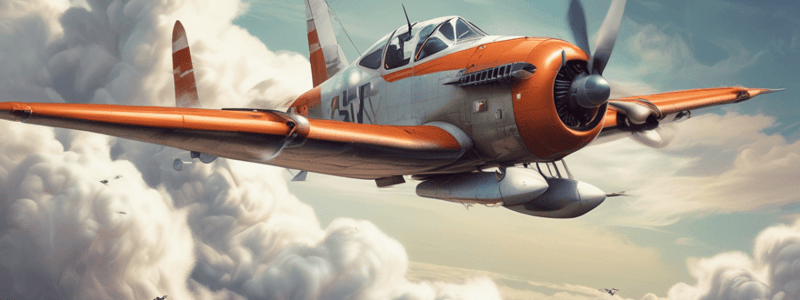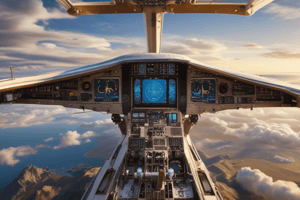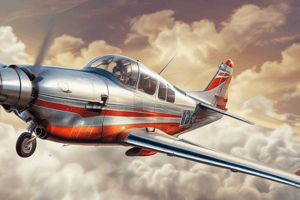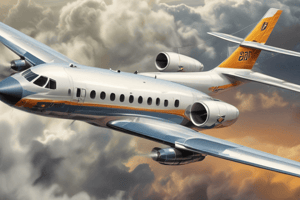Podcast
Questions and Answers
What is the primary reason for planning a route that takes advantage of favorable winds?
What is the primary reason for planning a route that takes advantage of favorable winds?
- To reduce fuel burn and increase efficiency (correct)
- To minimize the impact of potential weather disruptions
- To ensure a shorter flight duration
- To avoid areas with heavy air traffic
What is the purpose of continuously monitoring fuel consumption during flight?
What is the purpose of continuously monitoring fuel consumption during flight?
- To compare fuel burn with pre-flight calculations (correct)
- To adjust speed or altitude to improve efficiency
- To determine the exact fuel requirements for the flight
- To identify potential fuel leaks or system malfunctions
What is the primary advantage of adapting to real-time weather information during flight?
What is the primary advantage of adapting to real-time weather information during flight?
- To reduce the risk of weather-related disruptions
- To maintain a consistent flight schedule
- To ensure a safe and efficient flight (correct)
- To optimize fuel burn and reduce costs
What is the benefit of recalculating and adjusting cruising altitude or speed as fuel is consumed and the aircraft weight decreases?
What is the benefit of recalculating and adjusting cruising altitude or speed as fuel is consumed and the aircraft weight decreases?
What is the primary purpose of incorporating specific range calculations into the flight planning and in-flight decision-making process?
What is the primary purpose of incorporating specific range calculations into the flight planning and in-flight decision-making process?
What is the primary consideration when planning for emergency diversions or alternate destinations?
What is the primary consideration when planning for emergency diversions or alternate destinations?
What is the purpose of monitoring headwinds and tailwinds during flight?
What is the purpose of monitoring headwinds and tailwinds during flight?
What is the primary benefit of applying specific range knowledge during flight?
What is the primary benefit of applying specific range knowledge during flight?
What is the primary consideration when adjusting cruising altitude or speed during flight?
What is the primary consideration when adjusting cruising altitude or speed during flight?
What is the primary skill required for commercial pilots to effectively manage fuel during flight?
What is the primary skill required for commercial pilots to effectively manage fuel during flight?
The specific range of an aircraft is defined as the distance it can fly per unit of fuel consumed, and is only influenced by aircraft weight.
The specific range of an aircraft is defined as the distance it can fly per unit of fuel consumed, and is only influenced by aircraft weight.
Understanding specific range is only necessary for cruise altitude selection.
Understanding specific range is only necessary for cruise altitude selection.
The optimal cruising altitude can be determined using the aircraft's manufacturer performance charts and is always the highest altitude.
The optimal cruising altitude can be determined using the aircraft's manufacturer performance charts and is always the highest altitude.
Slower cruising speeds always result in lower fuel consumption.
Slower cruising speeds always result in lower fuel consumption.
Fuel load calculation for flight planning involves only determining the total fuel required for the flight.
Fuel load calculation for flight planning involves only determining the total fuel required for the flight.
Specific range knowledge is only necessary for flight planning and not for in-flight adjustments.
Specific range knowledge is only necessary for flight planning and not for in-flight adjustments.
Aircraft performance charts provide information on the optimal cruising speed for maximizing specific range.
Aircraft performance charts provide information on the optimal cruising speed for maximizing specific range.
The specific range of an aircraft is always constant and does not change during flight.
The specific range of an aircraft is always constant and does not change during flight.
In-flight adjustments to cruising altitude or speed do not affect fuel consumption.
In-flight adjustments to cruising altitude or speed do not affect fuel consumption.
The primary purpose of understanding specific range is to minimize flight time.
The primary purpose of understanding specific range is to minimize flight time.
How does understanding specific range enable pilots to optimize cruise performance during flight?
How does understanding specific range enable pilots to optimize cruise performance during flight?
What is the primary benefit of incorporating real-time weather information into in-flight decision-making?
What is the primary benefit of incorporating real-time weather information into in-flight decision-making?
How does monitoring fuel burn during flight support effective fuel management?
How does monitoring fuel burn during flight support effective fuel management?
What is the relationship between aircraft weight and specific range?
What is the relationship between aircraft weight and specific range?
Why is it essential for pilots to consider specific range calculations during emergency situations or diversions?
Why is it essential for pilots to consider specific range calculations during emergency situations or diversions?
How does adapting to real-time weather information support fuel efficiency during flight?
How does adapting to real-time weather information support fuel efficiency during flight?
What is the primary purpose of planning a route that takes advantage of favorable winds?
What is the primary purpose of planning a route that takes advantage of favorable winds?
How does understanding specific range support the development of a flight plan that minimizes fuel consumption?
How does understanding specific range support the development of a flight plan that minimizes fuel consumption?
What is the primary benefit of continuously monitoring fuel consumption during flight?
What is the primary benefit of continuously monitoring fuel consumption during flight?
Why is it essential for pilots to consider the interplay between aircraft systems, environmental factors, and operational requirements during flight?
Why is it essential for pilots to consider the interplay between aircraft systems, environmental factors, and operational requirements during flight?
Study Notes
Determining Specific Range
- Specific range is the distance an aircraft can travel per unit of fuel consumed, defined as the efficiency ratio of travel distance to fuel usage.
- Aircraft weight is a fundamental factor affecting specific range, as heavier aircraft burn more fuel to maintain lift, decreasing specific range.
- Altitude also impacts specific range, with higher altitudes requiring less fuel to achieve the same engine performance, improving specific range within the optimal altitude range.
- Airspeed variations influence specific range, with an optimal "Best Range Speed" where the aircraft is most fuel-efficient, and deviations from this point increasing fuel consumption.
- Aircraft aerodynamics, including wing shape, surface smoothness, and landing gear, affect drag, which impacts specific range.
- Fuel efficiency directly correlates with specific range, making engine performance and maintenance crucial.
- Accurate fuel flow measurement is essential for precise calculations of specific range.
- Performance charts are vital tools for pilots, enabling them to determine specific range under various conditions.
Cruise Control for Fuel Efficiency
- Cruise control settings can significantly impact fuel consumption, and precise management is critical for fuel efficiency and safety.
- The cruise phase of a flight typically consumes the majority of fuel onboard, making optimal throttle and mixture settings vital.
- Speed, altitude, and fuel consumption are interrelated, with higher speeds increasing drag and fuel consumption, but optimal altitude and speed combinations can minimize fuel burn.
- Understanding throttle and mixture control is crucial, as too-rich or too-lean mixtures can waste fuel or lead to engine problems.
- Modern avionics and flight management systems provide valuable assistance in optimizing fuel efficiency.
- Environmental factors like wind, temperature, and weight changes during flight require adjustments to cruise control settings to maintain optimal fuel efficiency.
Route Optimization and In-Flight Adjustments
- Route optimization involves planning a route that takes advantage of favorable winds and avoids areas with heavy air traffic or potential weather disruptions.
- In-flight adjustments include:
- Monitoring fuel burn and adjusting speed or altitude to improve efficiency.
- Adapting to real-time weather information to minimize fuel consumption.
- Reducing weight as fuel is consumed to optimize cruise performance.
- Considering emergency scenarios and recalculating fuel requirements to ensure safe diversion.
Determining Specific Range
- Specific range is the distance an aircraft can travel per unit of fuel consumed, and is a critical concept in aviation.
- It is defined as the efficiency ratio of travel distance to fuel usage.
- Factors affecting specific range:
- Aircraft weight: heavier aircraft burn more fuel, decreasing specific range.
- Altitude: higher altitudes can improve specific range due to thinner air, but only within optimal altitude range.
- Airspeed: there is a 'Best Range Speed' where the aircraft is most fuel-efficient.
- Aircraft aerodynamics: design elements like wing shape, surface smoothness, and landing gear affect drag, impacting specific range.
- Fuel efficiency: directly correlates with specific range, and depends on engine performance and maintenance.
- Accurate fuel flow measurement: crucial for precise calculations of specific range.
- Performance charts are essential for pilots to determine specific range under various conditions.
- Environmental conditions like wind speed, wind direction, and air temperature also impact specific range.
Cruise Control for Fuel Efficiency
- Cruise phase of flight typically consumes the majority of fuel onboard.
- Precise cruise control settings can significantly impact fuel consumption and range.
- Relationship between speed, altitude, and fuel consumption:
- Increasing speed increases drag, leading to higher fuel consumption.
- Optimal mixture of altitude and speed yields the best fuel efficiency.
- Throttle and mixture control are crucial for managing fuel:
- Too-rich mixture wastes fuel, while too-lean mixture may lead to engine problems.
- Refer to aircraft's flight manual for manufacturer-recommended settings.
- Modern avionics and flight management systems assist in optimizing for fuel efficiency.
- Adjusting cruise control settings in response to environmental factors like wind, temperature, and weight changes during flight is essential.
Applying Specific Range Knowledge
- Specific range is defined as the distance an aircraft can fly per unit of fuel consumed.
- Factors influencing specific range include aircraft weight, aerodynamic efficiency, engine performance, and atmospheric conditions.
- Applying specific range knowledge to flight planning:
- Fuel load calculation: determine total fuel required, including reserves, using specific range.
- Altitude selection: choose a cruising altitude that offers the best specific range.
- Speed considerations: select a cruising speed that maximizes specific range.
- In-flight adjustments: consider environmental factors and adjust cruise control settings accordingly.
Factors Affecting Specific Range
- Aerodynamic efficiency is crucial to maximize specific range
- Fuel efficiency directly correlates with specific range
- Engine performance and proper maintenance impact specific range
- Accurate fuel flow measurement is essential for precise calculations of specific range
- Performance charts help determine specific range under various conditions
Environmental Factors Affecting Specific Range
- Wind speed and direction can significantly impact specific range
- Tailwinds can extend specific range, while headwinds can reduce it
- Air temperature also affects specific range
Cruise Control for Fuel Efficiency
- Precise cruise control settings can significantly reduce fuel consumption
- Managing fuel is essential for flight safety and planning
- Cruise phase of a flight typically consumes the majority of fuel onboard
- Understanding how to manage throttle and mixture, as well as flight management systems, is crucial
Relationship Between Speed, Altitude, and Fuel Consumption
- As speed increases, drag increases, leading to higher fuel consumption
- Optimal mixture of altitude and speed yields the furthest distance on the least amount of fuel
- Altitude affects fuel efficiency, with thinner air reducing drag at higher altitudes
- Optimal altitude for every aircraft balances oxygen availability and reduced air resistance
Throttle and Mixture Control
- Too-rich mixture can waste fuel, while too lean a mixture may lead to engine problems
- Refer to aircraft's flight manual for manufacturer-recommended settings
Modern Avionics and Flight Management Systems
- Assist in optimizing for fuel efficiency by calculating the most efficient flight path
- Consider wind patterns, aircraft weight, and cruise altitude that yields the best fuel consumption for current conditions
Adjusting Cruise Control Settings
- Respond to environmental factors such as wind, temperature, and weight changes during flight
- For example, adjusting altitude and throttle setting to conserve fuel in response to wind patterns and temperatures
Applying Specific Range Knowledge to Flight Planning
- Fuel load calculation involves determining total fuel required for flight, including reserves
- Select cruising altitude that offers the best specific range for the aircraft
- Choose cruising speed that maximizes specific range
- Plan route that takes advantage of favorable winds and avoids areas with heavy air traffic or potential weather disruptions
In-Flight Adjustments
- Continuously monitor fuel consumption and compare with pre-flight calculations
- Adapt to real-time weather information, adjusting speed or altitude to improve efficiency
- Optimize cruise performance by recalculating and adjusting cruising altitude or speed as fuel is consumed and aircraft weight decreases
- Use specific range knowledge in emergency situations to quickly calculate new fuel requirements and adjust flight plan accordingly
Studying That Suits You
Use AI to generate personalized quizzes and flashcards to suit your learning preferences.
Related Documents
Description
Learn how to determine specific range in aircraft operation, building on previous knowledge of atmospheric conditions and their impact on performance.




